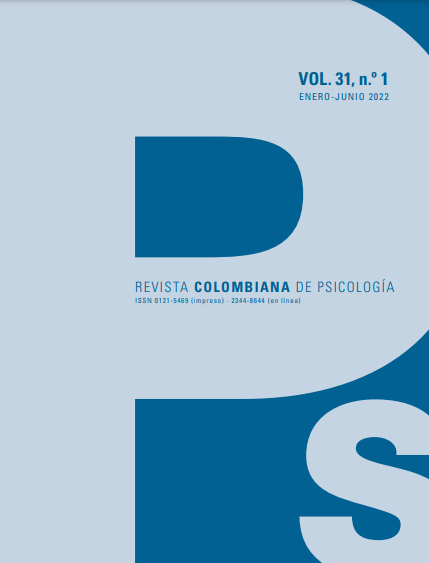Long-term Mate Selection in Latin America: An Analysis of Personal Ads
Selección de Parejas a Largo Plazo en Latinoamérica: Un Análisis de Anuncios Personales
DOI:
https://doi.org/10.15446/rcp.v31n1.89118Keywords:
lonely-heart ads, mate selection, mate preferences , sexual differences, sexual selection (en)anuncios personales, emparejamiento humano, diferencias sexuales, preferencias sexuales, selección sexual (es)
Downloads
The present work aims to study which factors are relevant in the long-term mate selection, from a Lonely-hearts personal advertisement sample of Spanish-speaking consumers of Cosmopolitan Magazine´s Colombian Edition. We analyzed 1468 publications (770 men and 698 women) using a coding system based on the theories of sexual strategies, genetic quality indicators and the preferences classification used in personal ads studies. Initially, we found trends as a greater predilection for psychological attributes and a greater demand to require more traits than offering them. In addition, the cross-cultural pattern demonstrated that men prefer women’s physical characteristics, while women require status/resources by men. Finally, men tended to be more selective in the age range of 36-45 years, while women’s selectivity decreased with age. The results replicate many of the patterns found in investigations related to human sexual selection, also bring enlightenment about new preference dimensions to study in the future.
How to cite this article: Moreno, L., Gutiérrez, G., Cruz, J., Javela, L., Gonzáles, M., & Rodríguez, J. (2022).
Long-term Mate Selection in Latin America: Evidence from Lonely-Heart Ads. Revista Colombiana de Psicología, 31 (1), 77-92. https://doi.org/10.15446/rcp.v31n1.89118
La presente investigación examina las preferencias de individuos que buscan emparejarse a largo plazo, por medio del análisis de anuncios de búsqueda de parejas, publicados por una muestra de usuarios hispanohablantes de la edición Colombiana de la Revista Cosmopolitan. Se revisaron 1468 publicaciones (de 770 hombres y 698 mujeres) utilizando un sistema de codificación construido a partir de la teoría de estrategias sexuales, indicadores de calidad genética y
clasificaciones usadas en estudios de anuncios personales. Los usuarios reportaron una mayor atención por atributos psicológicos, además de una alta exigencia. Adicionalmente, los hombres solicitaron más características físicas de las mujeres, y las mujeres más indicadores asociados al estatus y recursos de los hombres. Los hombres se mostraron más selectivos entre los 36 y los 45 años, mientras que la selectividad de las mujeres disminuyó con la edad. Los resultados replican patrones encontrados en las investigaciones sobre emparejamiento sexual humano, y dan luces sobre nuevos dominios de preferencia para examinar en el futuro.
Cómo citar este artículo: Moreno, L., Gutiérrez, G., Cruz, J., Javela, L., Gonzáles, M., & Rodríguez, J. (2022).
Long-term Mate Selection in Latin America: Evidence from Lonely-Heart Ads. Revista Colombiana de Psicología, 31 (1), 77-92. https://doi.org/10.15446/rcp.v31n1.89118
References
Baize, H. R., & Schroeder, J. E. (1995). Personality and mate selection in personal ads: evolutionary preferences in a public mate selection process. Journal of Social Behavior and Personality, 10(3), 517-536.
Bruch, E. E., & Newman, M. E. J. (2018). Aspirational pursuit of mates in online dating markets. Science Advances, 4(8), eaap9815. https://doi.org/10.1126/sciadv.aap9815 DOI: https://doi.org/10.1126/sciadv.aap9815
Burmann, C. G., Peláez, F., & Sánchez, S. (2002). Elección de pareja estable a través de anuncios de periódico [Choosing a stable partner through newspaper ads]. Psicothema, 14(2), 268-273. https://www.redalyc.org/pdf/727/72714213.pdf
Buss, D. M. (1989). Sex differences in human mate preferences: evolutionary hypotheses tested in 37 cultures. Behavioral and Brain Sciences, 12, 1–49. https://doi.org/10.1017/S0140525X00023992 DOI: https://doi.org/10.1017/S0140525X00023992
Buss, D. M., & Barnes, M. (1986). Preferences in human mate selection. Journal of Personality and Social Psychology, 50, 559–570. https://doi.org/10.1037/0022-3514.50.3.559 DOI: https://doi.org/10.1037/0022-3514.50.3.559
Buss, D. M., & Schmitt, D. P. (1993). Sexual strategies theory: an evolutionary perspective on human mating. Psychological Review, 100(2), 204-232. https://doi.org/10.1037/0033295X.100.2.204 DOI: https://doi.org/10.1037/0033-295X.100.2.204
Buss, D. M., & Shackelford, T. K. (2008). Attractive women want it all: good genes, economic investment, parenting proclivities, and emotional commitment. Evolutionary Psychology, 6(1), 134-146. https://doi.org/10.1177/147470490800600116 DOI: https://doi.org/10.1177/147470490800600116
Buss, D. M., Shackelford, T. K., Kirkpatrick, L. A., & Larsen, R. J. (2001). A half century of mate preferences: the cultural evolution of values. Journal of Marriage and Family, 63(2), 491-503. https://doi.org/10.1111/j.1741-3737.2001.00491.x DOI: https://doi.org/10.1111/j.1741-3737.2001.00491.x
Buss, D. M., & Schmitt, D. P. (2019). Mate preferences and their behavioral manifestations. Annual Review of Psychology, 70, 77-110. https://doi.org/10.1146/annurev-psych-010418-103408 DOI: https://doi.org/10.1146/annurev-psych-010418-103408
Cohen, J. (1960). A coefficient of agreement for nominal scales. Educational and Psychological Measurement, 20 (1): 37–46. https://doi.org/10.1177/001316446002000104 DOI: https://doi.org/10.1177/001316446002000104
Congreso de la República de Colombia. (2006). Ley 1090 del 6 de septiembre de 2006 por la cual se reglamenta el ejercicio profesional psicológico, se dicta el código deontológico y bioético [Law 1090 of September 6, 2006, which regulates psychological professional practice, dictates the deontological and bioethical code]. Congreso de la República de Colombia. https://www.funcionpublica.gov.co/eva/gestornormativo/norma.php?i=66205
Conroy-Beam D., Buss D.M. (2016) Mate preferences. In T. K. Shackelford & V. A. Weekes-Shackelford (Eds.), Encyclopedia of Evolutionary Psychological Science. Springer, Cham. https://doi.org/10.1007/978-3-319-16999-6_1-1 DOI: https://doi.org/10.1007/978-3-319-16999-6_1-1
Darwin, C. (1871). The descent of man, and selection in relation to sex (2 vols.). John Murray. DOI: https://doi.org/10.1037/12294-000
González, M., Javela, L., & Cruz, J. (2014, septiembre). Preferencias de edad en la selección de pareja en la sección punto de encuentro de la revista Cosmopolitan [Age preferences in partner selection in the meeting point section of Cosmopolitan magazine]. In J. Cruz (Coordinator), Desarrollos de la Psicología Evolucionista en Colombia. XVII Biennial Meeting of the International Society for Comparative Psychology, Bogotá. Colombia.
Greenless, I. A., & McGrew, W. C. (1994). Sex and age differences in preference and tactics of mate attraction: analysis of published advertisements. Ethology and Sociobiology, 15, 59-72. https://doi.org/10.1016/0162-3095(94)90017-5 DOI: https://doi.org/10.1016/0162-3095(94)90017-5
Gutiérrez, S. S., & Carranza, L. O. (2016). Preferencias en la elección de pareja entre estudiantes universitarios: un análisis según sexo [Preferences in choosing a partner among university students: an analysis according to sex]. Revista Tendencias en Psicología, 1(1), 16-27. http://revistas.upagu.edu.pe/index.php/TP/article/view/322
Hamon, R. R., & Ingoldsby, B. B. (Eds.) (2003). Mate selection across cultures. SAGE Publications, Inc. DOI: https://doi.org/10.4135/9781452204628
Henrich, J., Heine, S. J., & Norenzayan, A. (2010). Most people are not WEIRD. Nature, 466(7302), 29-29. https://doi.org/10.1038/466029a DOI: https://doi.org/10.1038/466029a
Hill, R. (1945). Campus values in mate selection. Journal of Home Economics, 37(554), 269.
Hitsch, G. J., Hortaçsu, A., & Ariely, D. (2010). What makes you click? Mate preferences in online dating. Quantitative Marketing and Economics, 8(4), 393-427. https://doi.org/10.1007/s11129-010-9088-6 DOI: https://doi.org/10.1007/s11129-010-9088-6
Howard, J. A., Blumstein, P., & Schwartz, P. (1987). Social or evolutionary theories? Some observations on preferences in human mate selection. Journal of Personality and Social Psychology, 53, 194–200. https://doi.org/10.1037/0022-3514.53.1.194 DOI: https://doi.org/10.1037/0022-3514.53.1.194
Huston, T. L., & Houts, R. M. (1998). The psychological infrastructure of courtship and marriage: the role of personality and compatibility in romantic relationships. In T. N. Bradbury (Ed.), The developmental course of marital dysfunction (pp. 114-151). Cambridge University Press. https://doi.org/10.1017/CBO9780511527814.006 DOI: https://doi.org/10.1017/CBO9780511527814.006
Lee, A. J., Dubbs, S. L., Von Hippel, W., Brooks, R. C., & Zietsch, B. P. (2014). A multivariate approach to human mate preferences. Evolution and Human Behavior, 35(3), 193-203. https://doi.org/10.1016/j.evolhumbehav.2014.01.003 DOI: https://doi.org/10.1016/j.evolhumbehav.2014.01.003
Li, N. P., Bailey, J. M., Kenrick, D. T., & Linsenmeier, J. A. (2002). The necessities and luxuries of mate preferences: testing the trade-offs. Journal of Personality and Social Psychology, 82(6), 947-955. https://doi.org/10.1037/0022-3514.82.6.947 DOI: https://doi.org/10.1037/0022-3514.82.6.947
Li, N. P., Valentine, K. A., & Patel, L. (2011). Mate preferences in the US and Singapore: a cross-cultural test of the mate preference priority model. Personality and Individual Differences, 50(2), 291-294. https://doi.org/10.1016/j.paid.2010.10.005 DOI: https://doi.org/10.1016/j.paid.2010.10.005
Medina, J. L. V., Fuentes, N. I. G. A. L., Valdez, J. A., Escobar, S. G., Morelato, G., & Ison, M. S. (2008). La elección de pareja real e ideal en dos culturas: México y Argentina. Un análisis por sexo [The choice of a real and ideal partner in two cultures: Mexico and Argentina. An analysis by sex]. Enseñanza e Investigación en Psicología, 13(2), 261-277. http://hdl.handle.net/20.500.11799/38867
Miller, G. F. (1998). A review of sexual selection and human evolution: how mate choice shaped human nature. In C. Crawford & D. Krebs (Eds.), Handbook of evolutionary psychology: ideas, issues, and applications (pp. 87-130). Lawrence Erlbaum.
Miller, G. (2011). The mating mind: How sexual choice shaped the evolution of human nature. Anchor.
Moreno, L., & Gutiérrez, G. (2021). Cómo el sexo moldea la evolución del comportamiento: el caso de las preferencias en la reproducción humana [How sex shapes the evolution of behavior: the case of preferences in human reproduction]. Suma Psicológica, 28(1), 25-36. https://doi.org/10.14349/sumapsi.2021.v28.n1.4 DOI: https://doi.org/10.14349/sumapsi.2021.v28.n1.4
Oda, R. (2001). Sexually dimorphic mate preference in Japan. An analysis of lonely-hearts advertisements. Human Nature, 12(3), 191-206. https://doi.org/10.1007/s12110-001-1006-x DOI: https://doi.org/10.1007/s12110-001-1006-x
Pisanski, K., & Feinberg, D. R. (2013). Cross-cultural variation in mate preferences for averageness, symmetry, body size, and masculinity. CrossCultural Research, 47(2), 162–197. https://doi.org/10.1177/1069397112471806 DOI: https://doi.org/10.1177/1069397112471806
Russock, H. I. (2011). An evolutionary interpretation of the effect of gender and sexual orientation on human mate selection preferences, as indicated by an analysis of personal advertisements. Behaviour, 148(3), 307-323. https://doi.org/10.1163/000579511X556600 DOI: https://doi.org/10.1163/000579511X556600
Schmitt, D. P. (2014). Evaluating evidence of mate preference adaptations: how do we really know what Homo Sapiens Sapiens really want? In V. Weekes-Shackelford & T. Shackelford (Eds.), Evolutionary perspectives on human sexual psychology and behavior (pp. 3-39). Springer. https://doi.org/10.1007/978-1-4939-0314-6_1 DOI: https://doi.org/10.1007/978-1-4939-0314-6_1
Schulz, J., Bahrami-Rad, D., Beauchamp, J., & Henrich, J. (2018). The origins of WEIRD psychology. Available at SSRN. http://dx.doi.org/10.2139/ssrn.3201031 DOI: https://doi.org/10.2139/ssrn.3201031
Sefcek, J. A., Brumbach, B. H., Vasquez, G., & Miller, G. F. (2007). The evolutionary psychology of human mate choice: how ecology, genes, fertility, and fashion influence mating strategies. Journal of Psychology & Human Sexuality, 18(2-3), 125-182. https://doi.org/10.1300/j056v18n02_05 DOI: https://doi.org/10.1300/J056v18n02_05
Shackelford, T. K., Schmitt, D. P., & Buss, D. M. (2005). Universal dimensions of human mate preferences. Personality and Individual Differences, 39(2), 447-458. https://doi.org/10.1016/j.paid.2005.01.023 DOI: https://doi.org/10.1016/j.paid.2005.01.023
Simpson, J. A., & Gangestad, S. W. (1992). Sociosexuality and romantic partner choice. Journal of Personality, 60, 31–51. https://doi.org/10.1111/j.1467-6494.1992.tb00264.x DOI: https://doi.org/10.1111/j.1467-6494.1992.tb00264.x
Thiessen, D., Young, R. K., & Burroughs, R. (1993). Lonely hearts advertisements reflect sexually dimorphic mating strategies. Ethology and Sociobiology, 14, 209-229. https://doi.org/10.1016/0162-3095(93)90007-5 DOI: https://doi.org/10.1016/0162-3095(93)90007-5
Trivers, R. (1972). Parental investment and sexual selection. En B. Campbell (Ed.), Sexual selection and the descent of man 1871-1971, (pp. 136-179). Aldine. DOI: https://doi.org/10.4324/9781315129266-7
Waynforth, D., & Dunbar, R. I. (1995). Conditional mate choice strategies in humans: evidence from ‘Lonely Hearts’ advertisements. Behaviour, 132(9), 755-779. https://doi.org/10.1163/156853995X00135 DOI: https://doi.org/10.1163/156853995X00135
Wiederman, M. W. (1993). Evolved gender differences in mate preferences: evidence from personal advertisements. Ethology and Sociobiology, 14, 331-352. https://doi.org/10.1016/0162-3095(93)90003-z DOI: https://doi.org/10.1016/0162-3095(93)90003-Z
Zahavi, A. (1975). Mate selection — a selection of handicap. Journal of Theoretical Biology, 53, 205-214. https://doi.org/10.1016/0022-5193(75)90111-3 DOI: https://doi.org/10.1016/0022-5193(75)90111-3
Zentner, M., & Eagly, A. H. (2015). A sociocultural framework for understanding partner preferences of women and men: Integration of concepts and evidence. European Review of Social Psychology, 26(1), 328-373. http://dx.doi.org/10.1080/10463283.2015.1111599 DOI: https://doi.org/10.1080/10463283.2015.1111599
Zentner, M., & Mitura, K. (2012). Stepping out of the caveman’s shadow: nations’ gender gap predicts degree of sex differentiation in mate preferences. Psychological Science, 23, 1176–1185. https://doi.org/10.1177/0956797612441004 DOI: https://doi.org/10.1177/0956797612441004
How to Cite
APA
ACM
ACS
ABNT
Chicago
Harvard
IEEE
MLA
Turabian
Vancouver
Download Citation
License
Copyright (c) 2022 Revista Colombiana de PsicologíaThe RCP is published under the Creative Commons license and can be copied and reproduced according to the conditions of this license (http://creativecommons.org/licenses/by-nc-nd/2.5). RCP articles are available online at https://revistas.unal.edu.co/index.php/psicologia/issue/archive. If you would like to subscribe to the RCP as reader, please go to https://revistas.unal.edu.co/index.php/psicologia/information/readers and follow the instructions mentioned in the webpage. Additionally, a limited number of print journals are available upon request. To request print copies, please email revpsico_fchbog@unal.edu.co.


























